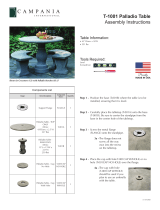Lego 21006 Architecture Building Instructions
- Type
- Building Instructions
This manual is also suitable for
Lego 21006 Architecture is a scale model of the White House, the official residence and principal workplace of the President of the United States. The set includes 470 pieces and is suitable for ages 12 and up. The model features the White House's iconic neoclassical design, with its white exterior, symmetrical facade, and columns. The set also includes a detailed interior, with rooms such as the Oval Office, the East Room, and the State Dining Room.
Lego 21006 Architecture is a scale model of the White House, the official residence and principal workplace of the President of the United States. The set includes 470 pieces and is suitable for ages 12 and up. The model features the White House's iconic neoclassical design, with its white exterior, symmetrical facade, and columns. The set also includes a detailed interior, with rooms such as the Oval Office, the East Room, and the State Dining Room.




















-
 1
1
-
 2
2
-
 3
3
-
 4
4
-
 5
5
-
 6
6
-
 7
7
-
 8
8
-
 9
9
-
 10
10
-
 11
11
-
 12
12
-
 13
13
-
 14
14
-
 15
15
-
 16
16
-
 17
17
-
 18
18
-
 19
19
-
 20
20
-
 21
21
-
 22
22
-
 23
23
-
 24
24
-
 25
25
-
 26
26
-
 27
27
-
 28
28
-
 29
29
-
 30
30
-
 31
31
-
 32
32
-
 33
33
-
 34
34
-
 35
35
-
 36
36
-
 37
37
-
 38
38
-
 39
39
-
 40
40
-
 41
41
-
 42
42
-
 43
43
-
 44
44
-
 45
45
-
 46
46
-
 47
47
-
 48
48
-
 49
49
-
 50
50
-
 51
51
-
 52
52
-
 53
53
-
 54
54
-
 55
55
-
 56
56
-
 57
57
-
 58
58
-
 59
59
-
 60
60
-
 61
61
-
 62
62
-
 63
63
-
 64
64
-
 65
65
-
 66
66
-
 67
67
-
 68
68
-
 69
69
-
 70
70
-
 71
71
-
 72
72
-
 73
73
-
 74
74
-
 75
75
-
 76
76
Lego 21006 Architecture Building Instructions
- Type
- Building Instructions
- This manual is also suitable for
Lego 21006 Architecture is a scale model of the White House, the official residence and principal workplace of the President of the United States. The set includes 470 pieces and is suitable for ages 12 and up. The model features the White House's iconic neoclassical design, with its white exterior, symmetrical facade, and columns. The set also includes a detailed interior, with rooms such as the Oval Office, the East Room, and the State Dining Room.
Ask a question and I''ll find the answer in the document
Finding information in a document is now easier with AI
Related papers
-
Lego 41907 DOTS Building Instructions
-
Lego 41914 DOTS Building Instructions
-
Lego 41904 DOTS Building Instructions
-
Lego 41915 DOTS Building Instructions
-
Lego 41924 DOTS User manual
-
Lego 30053 Installation guide
-
Lego 30054 Installation guide
-
Lego 40175 Building Instructions
-
Lego 40175 Building Instructions
-
Lego 10134 Star Wars Owner's manual
Other documents
-
Solstice Sculptures XST/441 User manual
-
Oreck ORECK DUAL MAX AIR16UK User manual
-
Digicom EDR 10 User manual
-
Oreck DualMax User manual
-
LIGHT MY BRICKS 21108 Operating instructions
-
Digicom Palladio USB Bluetooth EDR 100 User manual
-
 CAMPANIA T-1001 Assembly Instructions
CAMPANIA T-1001 Assembly Instructions
-
Verizon MCG-14062 Moultrie Mobile Delta Base Cellular Trail Camera User manual
-
Digicom Palladio USB Bluetooth User manual
-
Optimus DCS-3021C-W User manual












































































